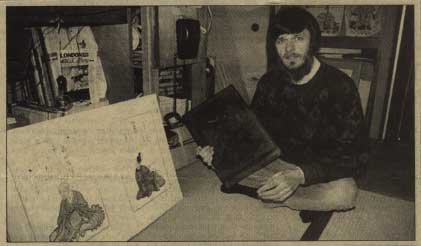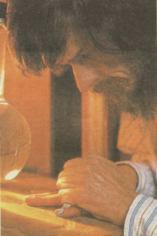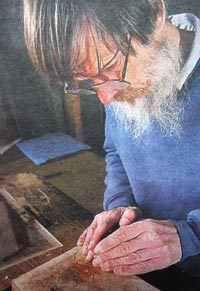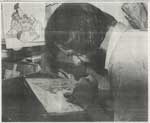Japanese Art with a Canadian Touch
A British-born artist from Canada is holding an exhibition of his 60 works of ukiyoe woodblock prints, part of his 10-year project to carve and print the Hyakunin Isshu poem collection.
Hyakunin Isshu is a set of 100 cards featuring 100 selected poems along with portraits of the poets who composed them.
Having lived in suburban Tokyo for nine years, David Bull has produced 10 prints a year since 1989 based on the original prints of Katsukawa Shunsho, an ukiyoe painter from the Edo Era.

In the Edo era, ukiyoe was produced by a painter, a carver, and a printer under the organization of a publisher.
The exhibition of the prints by David Bull will be held at the Grand Gallery Osaka from Jan. 30 to Feb. 4, following a recent Tokyo exhibition.
Born in Britain and brought up in Canada, Bull came across ukiyoe prints at a Toronto gallery while he was working for a music instrument leasing company.
Bull and his then wife toured Japan in 1981 and visited woodblock carvers in Asakusa Tokyo, with the hope of some day learning the craft. He moved to Japan with his family in July 1986 and started studying carving and printing techniques while earning a living by teaching English.
His 10-year Hyakunin Isshu project was initiated after he first saw Shunsho's paintings for the poem collection. He held the first exhibition in 1990. His works gradually gained recognition, and last year's exhibition sold 72 sets of 10 prints for 100,000 a set.
Bull says "Shunsho's work is actually very unusual; in most ukiyoe we can't see the personality, but in these portraits we can see the subject's deep personality."
"The old master carvers could carve lines that dance on the page. My lines don't move yet," he says.
TV Listings
The 'Woodblock Shimbun' has a full selection of TV programs on file. Videos available include some of David's news appearances, complete feature programs, and some short documentaries on his work. The files are in QuickTime format, and can be easily viewed with your browser.
Program listings are on the Index page ... ![]()
David Bull, Woodblock Printmaker
When I arrive at David Bull's home in Ome in Tokyo's western suburb on a cold but sunny morning in late March, he is checking a huge delivery of kiri wood boxes from China. But this time he is not quite satisfied ... (2007)
Full Story. ![]()
Recapturing Edo Images
Squatting in front of a photocopy of an ukiyo-e print in the light from a 50-watt bulb, David Bull puts his carving knife carefully to a block of cherry wood. Under his blade, the image of an elaborately robed Heian minister slowly begins to emerge. "The hardest thing about making woodblock prints is the carving of intricate lines - you have to be able to use your knife like a brush in order to do justice to the fine lines," Bull says. (1989)
Full Story. ![]()
The Blue-eyed Ukiyo-e Craftsman
 Midnight is the best time.
The noise and confusion of the day's activities has died down, my two
young daughters are lost in their dreams, the roar of the traffic
passing on the road outside has dwindled away to an occasional
murmur, and my hand is now steady and ready for the challenge. The
easy parts are done, the kimono designs, the lettering, the outlines.
Tonight I will carve the face - slicing away the rock-hard cherry
wood sliver by sliver, and watching as the delicate features of a
10th century court lady gradually take shape in the wood. (1992)
Midnight is the best time.
The noise and confusion of the day's activities has died down, my two
young daughters are lost in their dreams, the roar of the traffic
passing on the road outside has dwindled away to an occasional
murmur, and my hand is now steady and ready for the challenge. The
easy parts are done, the kimono designs, the lettering, the outlines.
Tonight I will carve the face - slicing away the rock-hard cherry
wood sliver by sliver, and watching as the delicate features of a
10th century court lady gradually take shape in the wood. (1992)
Full Story. ![]()



